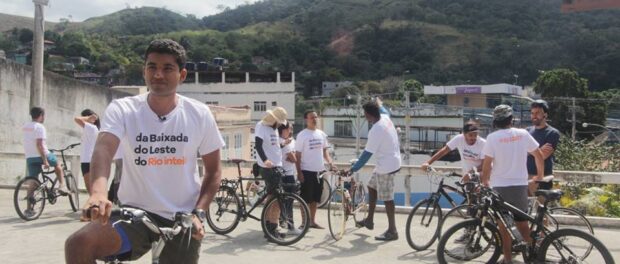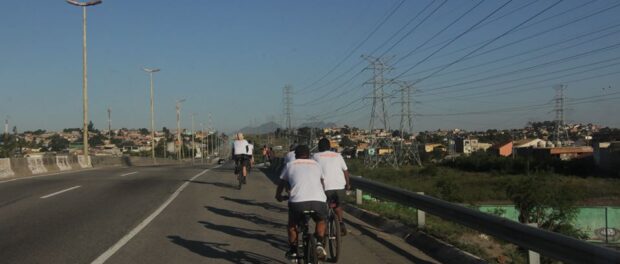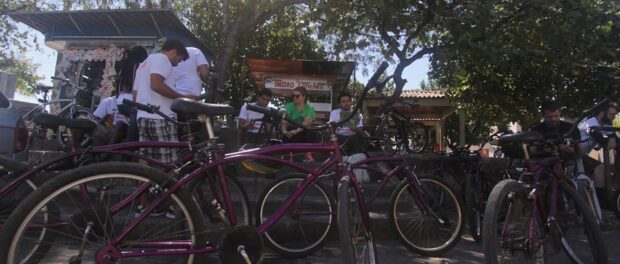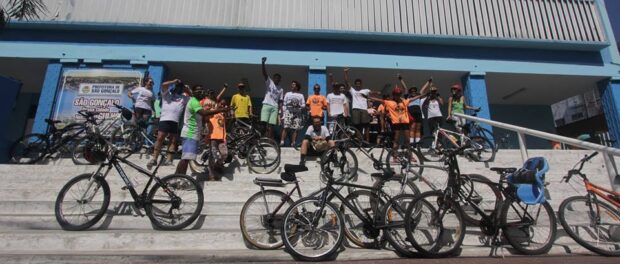
More than 50 cycling enthusiasts from the entire Rio metropolitan area came together last weekend for Casa Fluminense’s Bicicletada Metropolitana, a 3-day, 118 kilometer ride that departed Thursday morning, August 25, from Japeri in the Baixada Fluminense, and finished Saturday afternoon, August 27, at Praia das Pedrinhas in São Gonçalo, along the eastern shores of Guanabara Bay. The ride helped kick off the organization’s #Rio2017 campaign, which has harnessed the dialogue and participation of numerous civil society groups into its Agenda 2017, a list of actionable ideas to improve life in the city in the post-Olympic period.
“With the Rio2017 agenda we are presenting proposals to politicians in order to transform Rio into a more equal, democratic, and sustainable city,” said Henrique Silveira, a coordinator of the Bicicletada for the Casa Fluminense. “This bike ride is an effort to mobilize society and individual citizens to reflect on the future of Rio de Janeiro after the Olympics.”
On the opening day of the ride, the cyclists pedaled southeast from Japeri, in the outer Baixada region, through Nova Iguaçu and ultimately to their resting spot at Centro Cultural Lira de Ouro in Duque de Caxias. Along the route, the group met with members of Enraizados, a hip hop-focused community organization based in Nova Iguaçu.
Day two took the cyclists south from the Baixada towards the center of Rio, passing through Complexo da Maré where they were joined by children from the community and had a discussion of ideas with leaders from the Maré favelas. They finished their day in the Port Region, camping out at Spectaculu, an art and technology school housed in a converted warehouse.
On Saturday, the riders crossed the Guanabara Bay by ferry before heading north from Niterói to São Gonçalo, where they joined forces with an energetic local bike club for the home stretch. As he approached the finishing point, Guilherme Karakida, who also helped organize the ride, felt a moment of deep reflection. “Just as we were contemplating the beauty of the Guanabara Bay, what came across to me was the magnitude of the challenge that cleaning the bay poses, which is one of Casa Fluminense’s main goals,” he said.
Cyclists reported choosing to participate for a variety of reasons. Some were actively involved in the campaign while others simply thought seeing the city from end-to-end would be an eye-opening experience. But Carlos Leandro, of the group Queimados Pedaling Towards the Future, participated partly as training. Leandro began cycling as an economical solution after losing his job but now views the sport as both an affordable transit method and an enjoyable pastime. This Fall he intends to ride from Rio to Mariana, the town in Minas Gerais state where Brazil’s largest environmental catastrophe to date occurred–last November’s mining disaster–to produce a documentary to honor the victims.
The bikers noticed that the inequality in road quality throughout the city often mirrored wealth inequality. While in the Baixada and parts of the East Metropolitan Region they were forced to ride on busy roads or alongside the freeway, whereas the South Zone has miles of well-manicured bike paths. Members of the São Gonçalo bike club also bemoaned the poor conditions they are forced to ride through on a regular basis. According to Renan Braga, cyclist and resident of the North Zone neighborhood Méier: “In the South Zone the streets have trees, while in São Gonçalo there are no trees at all. The road designs in the South Zone and North Zone are very different.” He said that while neighborhoods like Copacabana have an organized system of small blocks, many areas in the North Zone have no blocks at all. “In many parts of the North Zone sidewalks are occupied illegally by property, and many businesses use sidewalks to display their products which makes biking difficult.”
Leaders of Casa Fluminense see numerous benefits to improving the cycling infrastructure in areas outside of the South Zone. “Active transportation democratizes public space and incentivizes relations between people. The city should be made for bicycles and people too, not just for cars,” said Karakida. Aside from being a political point of view, Karakida simply appreciates cycling as a healthy lifestyle choice. “Additionally, using a bike as a method of transportation produces a higher quality of life and releases endorphins.”



